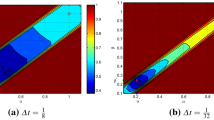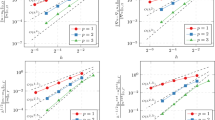Abstract
In this paper we present new efficient variants of substructuring preconditioners for algebraic linear systems arising from the mortar discretization of a degenerate parabolic system of equations. The new approaches extend and adapt the idea of substructuring preconditioners to the discretization of a degenerate problem in electrocardiology. A polylogarithmic bound for the condition number of the preconditioned matrix is proved and validated by numerical experiments.
Similar content being viewed by others
References
Achdou, Y., Maday, Y., Widlund, O.B.: Iterative substructuring preconditioners for mortar element methods in two dimensions. SIAM J. Numer. Anal. 36(2), 551–580 (1999)
Bertoluzza, S., Pennacchio, M.: Preconditioning the mortar method by substructuring: the high order case. Appl. Numer. Anal. Comput. Math. 1(3), 434–454 (2004)
Bertoluzza, S., Pennacchio, M.: Analysis of substructuring preconditioners for mortar methods in an abstract framework. Appl. Math. Lett. 20(2), 131–137 (2007)
Bertoluzza, S., Perrier, V.: The mortar method in the wavelet context. ESAIM Math. Model. Numer. Anal. 35, 647–673 (2001)
Bramble, J.H., Pasciak, J.E., Schatz, A.H.: The construction of preconditioners for elliptic problems by substructuring I. Math. Comput. 47(175), 103–134 (1986)
Chan, T.F., Mathew, T.P.: Domain decomposition algorithms. In: Acta Numerica 1994, pp. 61–143. Cambridge University Press, Cambridge (1994)
Cherry, E., Greenside, H., Henriquez, C.H.: Efficient simulation of three-dimensional anisotropic cardiac tissue using an adaptive mesh refinement method. Chaos 3, 853–865 (2003)
Ciarlet, P.G.: The Finite Element Method for Elliptic Problems. North-Holland, Amsterdam (1978)
Colli Franzone, P., Deuflhard, P., Erdmann, B., Lang, J., Pavarino, L.: Adaptivity in space and time for reaction-diffusion systems in electrocardiology. SIAM J. Sci. Comput. 28, 942–962 (2005)
Colli Franzone, P., Guerri, L.: Spreading of excitation in 3-D models of the anisotropic cardiac tissue. I: Validation of the eikonal model. Math. Biosci. 113, 145–209 (1993)
Colli Franzone, P., Pavarino, L.: A parallel solver for reaction-diffusion systems in computational electrocardiology. Math. Models Methods Appl. Sci. 14(6), 883–911 (2004)
Colli Franzone, P., Savaré, G.: Degenerate evolution systems modeling the cardiac electric field at micro and macroscopic level. In: Evolution Equations, Semigroups and Functional Analysis. Progress in Nonlinear Differential Equations and Their Applications, vol. 50, pp. 49–78. Birkhäuser, Basel (2002)
Dryja, M.: Substructuring methods for parabolic problems. In: Proceedings of the Fourth International Symposium on Domain Decomposition Methods for Partial Differential Equations, pp. 264–271. SIAM, Philadelphia (1991)
Grisvard, P.: Elliptic Problems in Nonsmooth Domains. Pitman, London (1985)
Henriquez, C., Muzikant, A., Smoak, C.: Anisotropy, fiber curvature, and bath loading effects on activation in thin and thick cardiac tissue preparations: Simulations in a three–dimensional bidomain model. J. Cardiovasc. Electrophysiol. 7, 424–444 (1996)
Henriquez, C.S.: Simulating the electrical behavior of cardiac tissue using the bidomain model. Crit. Rev. Biomed. Eng. 21, 1–77 (1993)
Hooke, N., Henriquez, C.S., Lanzkron, P., Rose, D.: Linear algebraic transformations of the bidomain equations: implications for numerical methods. Math. Biosci. 120, 127–145 (1994)
Keener, J., Bogar, K.: A numerical method for the solution of the bidomain equations in cardiac tissue. Chaos 8, 234–241 (1998)
Lines, G.T., Buist, M.L., Grøttum, P., Tveito, A.: Modeling the electrical activity of the heart: a bidomain model of the ventricles embedded in a torso. Comput. Vis. Sci. 5(4), 195–213 (2003)
Lions, J.L., Magenes, E.: Non-homogeneous Boundary Value Problems and Applications. Springer, Berlin (1972)
Luo, C., Rudy, Y.: A model of ventricular cardiac action potential: depolarization, repolarization, and their interaction. Circ. Res. 68, 1501–1526 (1991)
Pennacchio, M.: The mortar finite element method for cardiac reaction-diffusion models. In: Computers in Cardiology, vol. 31, pp. 509–512. IEEE, New York (2004)
Pennacchio, M.: The mortar finite element method for the cardiac “bidomain” model of extracellular potential. J. Sci. Comput. 20(2), 191–210 (2004)
Pennacchio, M.: Substructuring preconditioners for parabolic problems by the mortar method. Int. J. Numer. Anal. Model., to appear
Pennacchio, M., Savaré, G., Colli Franzone, P.: Multiscale modeling for the bioelectric activity of the heart. SIAM J. Math. Anal. 37(4), 1333–1370 (2006)
Pennacchio, M., Simoncini, V.: Efficient algebraic solution of reaction-diffusion systems for the cardiac excitation process. J. Comput. Appl. Math. 145(1), 49–70 (2002)
Pormann, J.B.: A modular simulation system for the bidomain equations. Ph.D. thesis, Dept. of Electrical and Computer Engineering, Duke University (1999)
Smith, B.F., Bjorstad, P.E., Gropp, W.D.: Parallel Multilevel Methods for Partial Differential Equations. Cambridge University Press, Cambridge (1986)
Toselli, A., Widlund, O.: Domain Decomposition Methods—Algorithms and Theory. Springer Series in Computational Mathematics, vol. 34. Springer, New York (2004)
Trangestein, J.A., Kim, C.: Operator splitting and adaptive mesh refinement for the Luo-Rudy I model. J. Comput. Phys. 196, 645–679 (2004)
Weber Dos Santos, R., Plank, G., Bauer, S., Vigmond, E.: Parallel multigrid preconditioner for the cardiac bidomain model. IEEE Trans. Biomed. Eng. 51, 1960–1968 (2004)
Wohlmuth, B.: Discretization Methods and Iterative Solvers Based on Domain Decomposition. Lecture Notes in Computational Science and Engineering, vol. 17. Springer, Berlin (2001)
Author information
Authors and Affiliations
Corresponding author
Rights and permissions
About this article
Cite this article
Pennacchio, M., Simoncini, V. Substructuring Preconditioners for Mortar Discretization of a Degenerate Evolution Problem. J Sci Comput 36, 391–419 (2008). https://doi.org/10.1007/s10915-008-9195-7
Received:
Revised:
Accepted:
Published:
Issue Date:
DOI: https://doi.org/10.1007/s10915-008-9195-7




